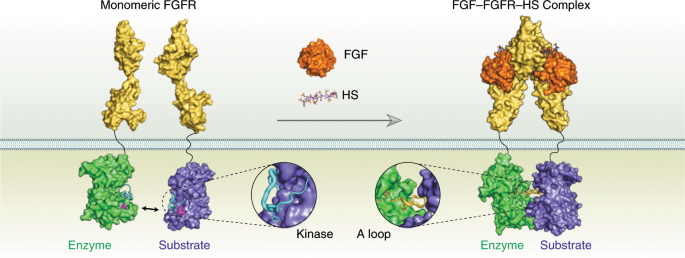
- Select a language for the TTS:
- UK English Female
- UK English Male
- US English Female
- US English Male
- Australian Female
- Australian Male
- Language selected: (auto detect) - EN
Play all audios:
ABSTRACT A long-standing mystery shrouds the mechanism by which catalytically repressed receptor tyrosine kinase domains accomplish transphosphorylation of activation loop (A-loop)
tyrosines. Here we show that this reaction proceeds via an asymmetric complex that is thermodynamically disadvantaged because of an electrostatic repulsion between enzyme and substrate
kinases. Under physiological conditions, the energetic gain resulting from ligand-induced dimerization of extracellular domains overcomes this opposing clash, stabilizing the
A-loop-transphosphorylating dimer. A unique pathogenic fibroblast growth factor receptor gain-of-function mutation promotes formation of the complex responsible for phosphorylation of A-loop
tyrosines by eliminating this repulsive force. We show that asymmetric complex formation induces a more phosphorylatable A-loop conformation in the substrate kinase, which in turn promotes
the active state of the enzyme kinase. This explains how quantitative differences in the stability of ligand-induced extracellular dimerization promotes formation of the intracellular
A-loop-transphosphorylating asymmetric complex to varying extents, thereby modulating intracellular kinase activity and signaling intensity. Access through your institution Buy or subscribe
This is a preview of subscription content, access via your institution ACCESS OPTIONS Access through your institution Access Nature and 54 other Nature Portfolio journals Get Nature+, our
best-value online-access subscription $29.99 / 30 days cancel any time Learn more Subscribe to this journal Receive 12 print issues and online access $259.00 per year only $21.58 per issue
Learn more Buy this article * Purchase on SpringerLink * Instant access to full article PDF Buy now Prices may be subject to local taxes which are calculated during checkout ADDITIONAL
ACCESS OPTIONS: * Log in * Learn about institutional subscriptions * Read our FAQs * Contact customer support SIMILAR CONTENT BEING VIEWED BY OTHERS THE COMBINED ACTION OF THE INTRACELLULAR
REGIONS REGULATES FGFR2 KINASE ACTIVITY Article Open access 14 July 2023 AN ALLOSTERIC SWITCH BETWEEN THE ACTIVATION LOOP AND A C-TERMINAL PALINDROMIC PHOSPHO-MOTIF CONTROLS C-SRC FUNCTION
Article Open access 17 October 2023 MECHANISM FOR THE ACTIVATION OF THE ANAPLASTIC LYMPHOMA KINASE RECEPTOR Article 24 November 2021 DATA AVAILABILITY Atomic coordinates and structure
factors of the FGFR3R669E asymmetric complex have been deposited in the Protein Data Bank under accession 6PNX. Raw mass spectrometry files and Mascot generic format files have been
deposited in the MassIVE database under accession MSV000084018. All other data generated or analyzed during this study are included in this published article and its associated Supplementary
Information. REFERENCES * Hunter, T. Signaling–2000 and beyond. _Cell_ 100, 113–127 (2000). CAS PubMed Google Scholar * Lemmon, M. A. & Schlessinger, J. Cell signaling by receptor
tyrosine kinases. _Cell_ 141, 1117–1134 (2010). CAS PubMed PubMed Central Google Scholar * Blume-Jensen, P. & Hunter, T. Oncogenic kinase signalling. _Nature_ 411, 355–365 (2001).
CAS PubMed Google Scholar * Hubbard, S. R. Autoinhibitory mechanisms in receptor tyrosine kinases. _Front Biosci._ 7, d330–d340 (2002). CAS PubMed Google Scholar * Hubbard, S. R.
Juxtamembrane autoinhibition in receptor tyrosine kinases. _Nat. Rev. Mol. Cell Biol._ 5, 464–471 (2004). CAS PubMed Google Scholar * Schlessinger, J. Signal transduction. Autoinhibition
control. _Science_ 300, 750–752 (2003). CAS PubMed Google Scholar * Wybenga-Groot, L. E. et al. Structural basis for autoinhibition of the Ephb2 receptor tyrosine kinase by the
unphosphorylated juxtamembrane region. _Cell_ 106, 745–757 (2001). CAS PubMed Google Scholar * Hubbard, S. R. & Miller, W. T. Receptor tyrosine kinases: mechanisms of activation and
signaling. _Curr. Opin. Cell Biol._ 19, 117–123 (2007). CAS PubMed PubMed Central Google Scholar * Zhang, X., Gureasko, J., Shen, K., Cole, P. A. & Kuriyan, J. An allosteric
mechanism for activation of the kinase domain of epidermal growth factor receptor. _Cell_ 125, 1137–1149 (2006). CAS PubMed Google Scholar * Kovacs, E., Zorn, J. A., Huang, Y., Barros, T.
& Kuriyan, J. A structural perspective on the regulation of the epidermal growth factor receptor. _Annu. Rev. Biochem._ 84, 739–764 (2015). CAS PubMed PubMed Central Google Scholar
* Jura, N. et al. Catalytic control in the EGF receptor and its connection to general kinase regulatory mechanisms. _Mol. Cell_ 42, 9–22 (2011). CAS PubMed PubMed Central Google Scholar
* Nolen, B., Taylor, S. & Ghosh, G. Regulation of protein kinases; controlling activity through activation segment conformation. _Mol. Cell_ 15, 661–675 (2004). CAS PubMed Google
Scholar * Pellicena, P. & Kuriyan, J. Protein–protein interactions in the allosteric regulation of protein kinases. _Curr. Opin. Struct. Biol._ 16, 702–709 (2006). CAS PubMed Google
Scholar * Boggon, T. J. & Eck, M. J. Structure and regulation of Src family kinases. _Oncogene_ 23, 7918–7927 (2004). CAS PubMed Google Scholar * Binns, K. L., Taylor, P. P.,
Sicheri, F., Pawson, T. & Holland, S. J. Phosphorylation of tyrosine residues in the kinase domain and juxtamembrane region regulates the biological and catalytic activities of Eph
receptors. _Mol. Cell. Biol._ 20, 4791–4805 (2000). CAS PubMed PubMed Central Google Scholar * Furdui, C. M., Lew, E. D., Schlessinger, J. & Anderson, K. S. Autophosphorylation of
FGFR1 kinase is mediated by a sequential and precisely ordered reaction. _Mol. Cell_ 21, 711–717 (2006). CAS PubMed Google Scholar * Wu, J. et al. Small-molecule inhibition and
activation-loop trans-phosphorylation of the IGF1 receptor. _EMBO J._ 27, 1985–1994 (2008). CAS PubMed PubMed Central Google Scholar * Kan, S. H. et al. Genomic screening of fibroblast
growth-factor receptor 2 reveals a wide spectrum of mutations in patients with syndromic craniosynostosis. _Am. J. Hum. Genet._ 70, 472–486 (2002). CAS PubMed PubMed Central Google
Scholar * McDonell, L. M., Kernohan, K. D., Boycott, K. M. & Sawyer, S. L. Receptor tyrosine kinase mutations in developmental syndromes and cancer: two sides of the same coin. _Hum.
Mol. Genet._ 24, R60–R66 (2015). CAS PubMed PubMed Central Google Scholar * Wilkie, A. O. Bad bones, absent smell, selfish testes: the pleiotropic consequences of human FGF receptor
mutations. _Cytokine Growth Factor Rev._ 16, 187–203 (2005). CAS PubMed Google Scholar * Chen, H. et al. A molecular brake in the kinase hinge region regulates the activity of receptor
tyrosine kinases. _Mol. Cell_ 27, 717–730 (2007). PubMed PubMed Central Google Scholar * Chen, H. et al. Elucidation of a four-site allosteric network in fibroblast growth factor receptor
tyrosine kinases. _Elife_ 6, e21137 (2017). PubMed PubMed Central Google Scholar * Rosen, M. K. et al. Selective methyl group protonation of perdeuterated proteins. _J. Mol. Biol._ 263,
627–636 (1996). CAS PubMed Google Scholar * Pervushin, K., Riek, R., Wider, G. & Wuthrich, K. Attenuated T2 relaxation by mutual cancellation of dipole–dipole coupling and chemical
shift anisotropy indicates an avenue to NMR structures of very large biological macromolecules in solution. _Proc. Natl Acad. Sci. USA_ 94, 12366–12371 (1997). CAS PubMed PubMed Central
Google Scholar * Mittermaier, A. & Meneses, E. Analyzing protein–ligand interactions by dynamic NMR spectroscopy. _Methods Mol. Biol._ 1008, 243–266 (2013). CAS PubMed Google Scholar
* Mittermaier, A. K. & Kay, L. E. Observing biological dynamics at atomic resolution using NMR. _Trends Biochem. Sci._ 34, 601–611 (2009). CAS PubMed Google Scholar * Chen, H. et
al. Cracking the molecular origin of intrinsic tyrosine kinase activity through analysis of pathogenic gain-of-function mutations. _Cell Rep._ 4, 376–384 (2013). CAS PubMed PubMed Central
Google Scholar * Huang, Z. et al. Structural mimicry of A-loop tyrosine phosphorylation by a pathogenic FGF receptor 3 mutation. _Structure_ 21, 1889–1896 (2013). CAS PubMed Google
Scholar * Korzhnev, D. M., Kloiber, K., Kanelis, V., Tugarinov, V. & Kay, L. E. Probing slow dynamics in high molecular weight proteins by methyl-TROSY NMR spectroscopy: application to
a 723-residue enzyme. _J. Am. Chem. Soc._ 126, 3964–3973 (2004). CAS PubMed Google Scholar * Winn, M. D. et al. Overview of the CCP4 suite and current developments. _Acta Crystallogr. D.
Biol. Crystallogr._ 67, 235–242 (2011). CAS PubMed PubMed Central Google Scholar * Adams, P. D. et al. PHENIX: a comprehensive Python-based system for macromolecular structure solution.
_Acta Crystallogr. D. Biol. Crystallogr._ 66, 213–221 (2010). CAS PubMed PubMed Central Google Scholar * Emsley, P. & Cowtan, K. Coot: model-building tools for molecular graphics.
_Acta Crystallogr. D. Biol. Crystallogr._ 60, 2126–2132 (2004). PubMed Google Scholar * Songyang, Z. et al. Catalytic specificity of protein-tyrosine kinases is critical for selective
signalling. _Nature_ 373, 536–539 (1995). CAS PubMed Google Scholar * Rappsilber, J., Mann, M. & Ishihama, Y. Protocol for micro-purification, enrichment, pre-fractionation and
storage of peptides for proteomics using StageTips. _Nat. Protoc._ 2, 1896–1906 (2007). CAS PubMed Google Scholar * Byron, S. A. et al. The N550K/H mutations in FGFR2 confer differential
resistance to PD173074, dovitinib, and ponatinib ATP-competitive inhibitors. _Neoplasia_ 15, 975–988 (2013). PubMed PubMed Central Google Scholar * Maier, J. A. et al. ff14SB: improving
the accuracy of protein side chain and backbone parameters from ff99SB. _J. Chem. Theory Comput._ 11, 3696–3713 (2015). CAS PubMed PubMed Central Google Scholar * Meagher, K. L., Redman,
L. T. & Carlson, H. A. Development of polyphosphate parameters for use with the AMBER force field. _J. Comput. Chem._ 24, 1016–1025 (2003). CAS PubMed Google Scholar * Allner, O.,
Nilsson, L. & Villa, A. Magnesium ion–water coordination and exchange in biomolecular simulations. _J. Chem. Theory Comput._ 8, 1493–1502 (2012). CAS PubMed Google Scholar * Webb, B.
& Sali, A. Protein structure modeling with MODELLER. _Curr. Protoc. Bioinformatics_ 54, 5.6.1–5.6.37 (2017). Google Scholar * Bae, J. H. et al. Asymmetric receptor contact is required
for tyrosine autophosphorylation of fibroblast growth factor receptor in living cells. _Proc. Natl Acad. Sci. USA_ 107, 2866–2871 (2010). CAS PubMed PubMed Central Google Scholar *
Salomon-Ferrer, R., Gotz, A. W., Poole, D., Le Grand, S. & Walker, R. C. Routine microsecond molecular dynamics simulations with AMBER on GPUs. 2. explicit solvent particle mesh ewald.
_J. Chem. Theory Comput._ 9, 3878–3888 (2013). CAS PubMed Google Scholar * Delaglio, F. et al. NMRPipe: a multidimensional spectral processing system based on UNIX pipes. _J. Biomol. NMR_
6, 277–293 (1995). CAS PubMed Google Scholar * Carver, J. P. & Richards, R. E. General 2-site solution for chemical exchange produced dependence of T2 upon Carr–Purcell pulse
separation. _J. Magn. Reson._ 6, 89–105 (1972). CAS Google Scholar * Luz, Z. & Meiboom, S. Nuclear magnetic resonance study of the protolysis of trimethylammonium ion in aqueous
solution-order of the reaction with respect to solvent. _J. Chem. Phys._ 39, 366–370 (1963). CAS Google Scholar Download references ACKNOWLEDGEMENTS The authors are indebted to N. Cowan
for critically reading and editing the manuscript. This work was supported by National Institute of Dental and Craniofacial Research (NIDCR) grant R01 DE13686 (to M.M.), National Institute
of General Medical Sciences (NIGMS) grant R01 GM117118 (to N.J.T.), NIGMS grant R35 GM127040 (to Y.Z.), National Institute of Neurological Disorders and Stroke (NINDS) grant P30 NS050276 and
Shared Instrumentation Grant RR027990 (to T.A.N.), China Scholarship Council (CSC) and China Association for Science and Technology (CAST) (to L.C.), National Cancer Institute (NCI)
predoctoral grant F99CA212474 (to W.M.M.) and the Natural Science Foundation of China (NSFC) grant 81930108 (to G.L.). An NMR cryoprobe at New York University was supported by an NIH S10
grant (OD016343). Data collection at the New York Structural Biology Center was made possible by a grant from NYSTAR. Computing resources were provided by New York University-ITS. We
dedicate this work to the memory of J.M., who died suddenly before submission. AUTHOR INFORMATION Author notes * These authors contributed equally: Lingfeng Chen, William M. Marsiglia,
Huaibin Chen. * Deceased: Jinghong Ma AUTHORS AND AFFILIATIONS * School of Chemical Engineering, Nanjing University of Science and Technology, Nanjing, China Lingfeng Chen & Guang Liang
* Department of Biochemistry and Molecular Pharmacology, New York University School of Medicine, New York, NY, USA Lingfeng Chen, Huaibin Chen, Lili Fu, Jinghong Ma & Moosa Mohammadi *
Chemical Biology Research Center, School of Pharmaceutical Sciences, Wenzhou Medical University, Wenzhou, Zhejiang, China Lingfeng Chen, Lili Fu, Guang Liang & Xiaokun Li * Department of
Chemistry, New York University, New York, NY, USA William M. Marsiglia, Joseph Katigbak, Yingkai Zhang & Nathaniel J. Traaseth * Department of Cell Biology and Skirball Institute of
Biomolecular Medicine, New York University School of Medicine, New York, NY, USA Hediye Erdjument-Bromage & Thomas A. Neubert * Department of Cell and Molecular Biology, University of
Rhode Island, Kingston, RI, USA David J. Kemble & Gongqin Sun Authors * Lingfeng Chen View author publications You can also search for this author inPubMed Google Scholar * William M.
Marsiglia View author publications You can also search for this author inPubMed Google Scholar * Huaibin Chen View author publications You can also search for this author inPubMed Google
Scholar * Joseph Katigbak View author publications You can also search for this author inPubMed Google Scholar * Hediye Erdjument-Bromage View author publications You can also search for
this author inPubMed Google Scholar * David J. Kemble View author publications You can also search for this author inPubMed Google Scholar * Lili Fu View author publications You can also
search for this author inPubMed Google Scholar * Jinghong Ma View author publications You can also search for this author inPubMed Google Scholar * Gongqin Sun View author publications You
can also search for this author inPubMed Google Scholar * Yingkai Zhang View author publications You can also search for this author inPubMed Google Scholar * Guang Liang View author
publications You can also search for this author inPubMed Google Scholar * Thomas A. Neubert View author publications You can also search for this author inPubMed Google Scholar * Xiaokun Li
View author publications You can also search for this author inPubMed Google Scholar * Nathaniel J. Traaseth View author publications You can also search for this author inPubMed Google
Scholar * Moosa Mohammadi View author publications You can also search for this author inPubMed Google Scholar CONTRIBUTIONS H.C. purified and crystallized FGFR3KR669E, and contributed to
the initial analysis of the crystal structure. L.C. expressed and purified all structure-based FGFRK proteins, established stable cell lines, generated cell-based and kinase assay data (Fig.
1, 4 and 6 and Supplementary Figs. 2, 8, 9 and 14–16), prepared the structural figures and participated in the design of experiments and in editing and revising the manuscript. W.M.M.
expressed and purified all FGFR2K samples for NMR studies, acquired and interpreted the NMR data (Figs. 3 and 6, and Supplementary Figs. 5, 7 and 10–12) and participated in editing and
revising the manuscript. G.S. and D.J.K. provided the catalytic turnover rates data (Fig. 1a and Supplementary Fig. 1). T.A.N. and H.E.-B. generated and interpreted LC–MS data. G.L. and X.L.
contributed to manuscript revision. J.M. and L.F. engineered bacterial and lentiviral expression constructs. J.K. and Y.Z. provided the molecular dynamics simulation data (Supplementary
Fig. 6). N.J.T. directed the NMR studies, interpreted NMR datasets, and participated in writing the manuscript. M.M. conceived and directed the project, solved, refined, analyzed and
interpreted the crystal structure of the FGFR3KR669E asymmetric complex and wrote the manuscript. CORRESPONDING AUTHORS Correspondence to Nathaniel J. Traaseth or Moosa Mohammadi. ETHICS
DECLARATIONS COMPETING INTERESTS The authors have no conflicting interest to report ADDITIONAL INFORMATION PUBLISHER’S NOTE Springer Nature remains neutral with regard to jurisdictional
claims in published maps and institutional affiliations. SUPPLEMENTARY INFORMATION SUPPLEMENTARY INFORMATION Supplementary Tables 1–3 and Supplementary Figs. 1–16 REPORTING SUMMARY RIGHTS
AND PERMISSIONS Reprints and permissions ABOUT THIS ARTICLE CITE THIS ARTICLE Chen, L., Marsiglia, W.M., Chen, H. _et al._ Molecular basis for receptor tyrosine kinase A-loop tyrosine
transphosphorylation. _Nat Chem Biol_ 16, 267–277 (2020). https://doi.org/10.1038/s41589-019-0455-7 Download citation * Received: 03 August 2019 * Revised: 05 December 2019 * Accepted: 13
December 2019 * Published: 20 January 2020 * Issue Date: March 2020 * DOI: https://doi.org/10.1038/s41589-019-0455-7 SHARE THIS ARTICLE Anyone you share the following link with will be able
to read this content: Get shareable link Sorry, a shareable link is not currently available for this article. Copy to clipboard Provided by the Springer Nature SharedIt content-sharing
initiative








